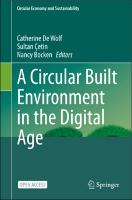| dc.contributor.editor | De Wolf, Catherine | |
| dc.contributor.editor | Çetin, Sultan | |
| dc.contributor.editor | Bocken, Nancy M. P. | |
| dc.date.accessioned | 2024-01-15T16:45:28Z | |
| dc.date.available | 2024-01-15T16:45:28Z | |
| dc.date.issued | 2024 | |
| dc.identifier | ONIX_20240115_9783031396755_18 | |
| dc.identifier | OCN: 1416911593 | |
| dc.identifier.uri | https://library.oapen.org/handle/20.500.12657/86890 | |
| dc.description.abstract | This open access book offers a comprehensive exploration of the digital innovations that have emerged in recent years for the circular built environment. Each chapter is meticulously crafted to ensure that both academic readers and industry practitioners can grasp the inner workings of each digital technology, understand its relevance to the circular built environment, examine real-life implementations, and appreciate the intriguing business models behind them. Our primary objective is to blend scholarly knowledge with practical inspiration by providing real-life case studies for each innovation. The authors, who possess extensive expertise in their respective fields, have contributed chapters dedicated to digital technologies within their areas of specialization. The book is organized into three distinct parts. The first part focuses on data-driven digital technologies and delves into how their capabilities can facilitate the transition to a circular built environment. Essential aspects such as building information modeling (BIM), digital twins, geographical information systems (GIS), scanning technologies, artificial intelligence (AI), data templates, and material passports are explored as vital tools for data collection, integration, and analysis in the context of circular construction. In the second part, various digital technologies for design and fabrication are introduced. Topics covered include computational design algorithms, additive and subtractive manufacturing, robotic manufacturing, and extended reality. These discussions shed light on how these technologies can be leveraged to enhance design and fabrication processes within the circular built environment. Finally, the last part of the book presents emerging digital concepts related to business and governance. It explores the role of deconstruction and reverse logistics, blockchain technology, digital building logbooks, and innovative business models as enablers of circularity in the built environment. The book concludes with a chapter dedicated to digital transformation and its potential to propel the built environment towards a regenerative future. In addition to the substantive content, the book features forewords and perspectives from esteemed experts, providing valuable economic and creative insights to complement its comprehensive approach. | |
| dc.language | English | |
| dc.relation.ispartofseries | Circular Economy and Sustainability | |
| dc.subject.classification | bic Book Industry Communication::T Technology, engineering, agriculture::TN Civil engineering, surveying & building::TNK Building construction & materials | |
| dc.subject.classification | bic Book Industry Communication::T Technology, engineering, agriculture::TQ Environmental science, engineering & technology::TQD Environmental monitoring | |
| dc.subject.classification | bic Book Industry Communication::R Earth sciences, geography, environment, planning::RN The environment::RNU Sustainability | |
| dc.subject.classification | bic Book Industry Communication::P Mathematics & science::PB Mathematics::PBT Probability & statistics | |
| dc.subject.classification | bic Book Industry Communication::U Computing & information technology::UF Business applications::UFM Mathematical & statistical software | |
| dc.subject.other | Digital innovations in the construction sector | |
| dc.subject.other | Applications in the construction sector | |
| dc.subject.other | Circular economy in the built environment | |
| dc.subject.other | Digital construction | |
| dc.subject.other | Addititive manufacturing | |
| dc.subject.other | Robotic manufacturing and artificial intelligence | |
| dc.subject.other | Big data and analytics | |
| dc.subject.other | Blockchain | |
| dc.subject.other | Circular business models | |
| dc.title | A Circular Built Environment in the Digital Age | |
| dc.type | book | |
| oapen.identifier.doi | 10.1007/978-3-031-39675-5 | |
| oapen.relation.isPublishedBy | 6c6992af-b843-4f46-859c-f6e9998e40d5 | |
| oapen.relation.isFundedBy | 8ddc66ac-0a88-489f-a679-47216f84739a | |
| oapen.relation.isFundedBy | c8e3795e-22c6-436f-bb7e-489d6737c46d | |
| oapen.relation.isFundedBy | 6a46b10f-375a-4ee4-ac78-84a20cba7c24 | |
| oapen.relation.isbn | 9783031396755 | |
| oapen.relation.isbn | 9783031396748 | |
| oapen.imprint | Springer International Publishing | |
| oapen.pages | 286 | |
| oapen.place.publication | Cham | |
| oapen.grant.number | [...] | |
| oapen.grant.number | [...] | |
| oapen.grant.number | [...] | |

